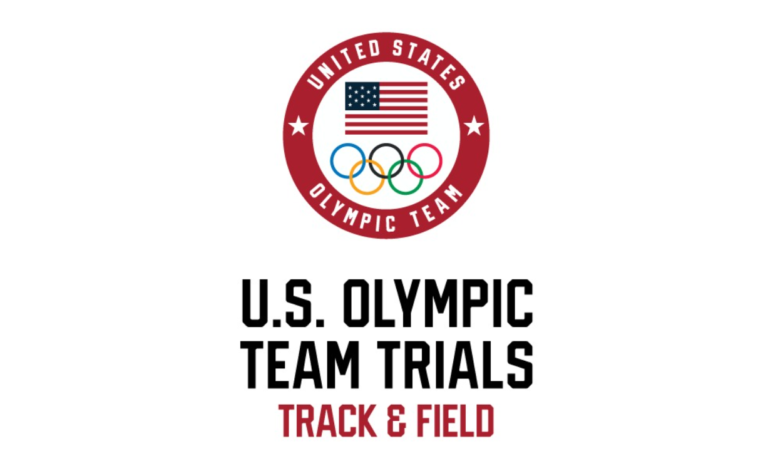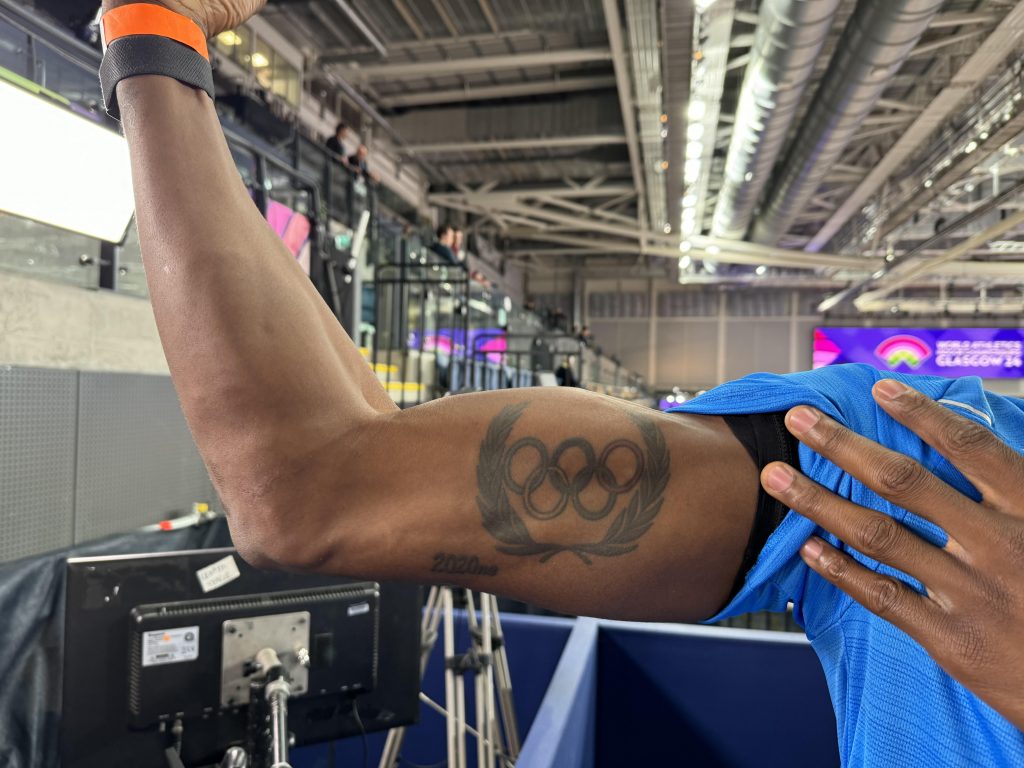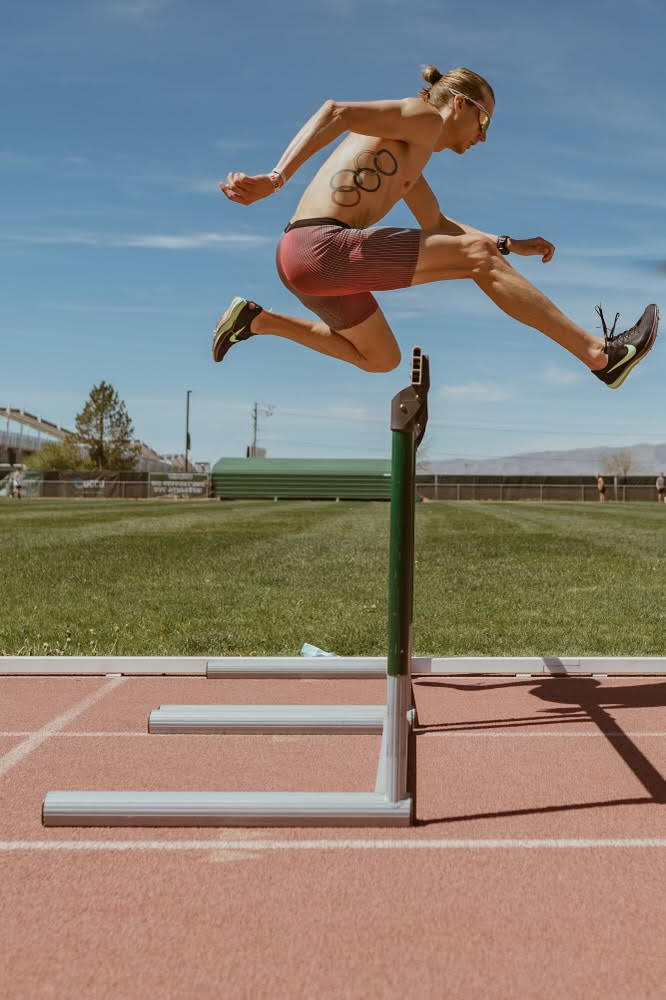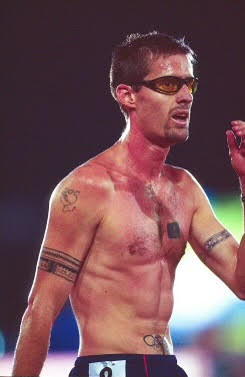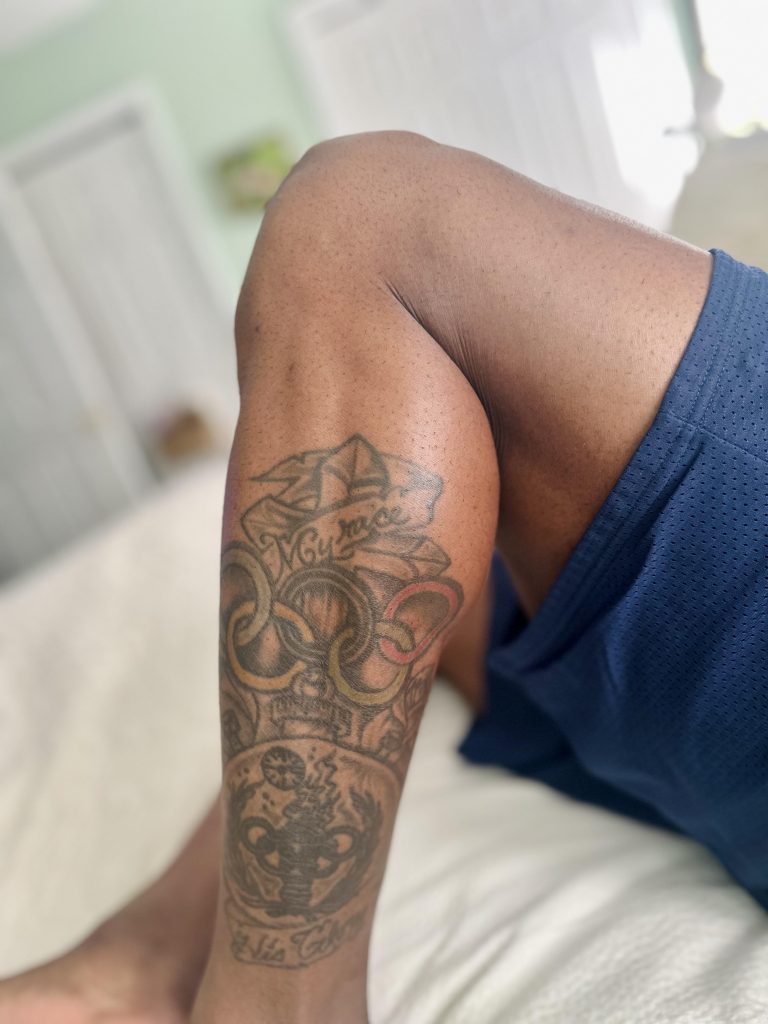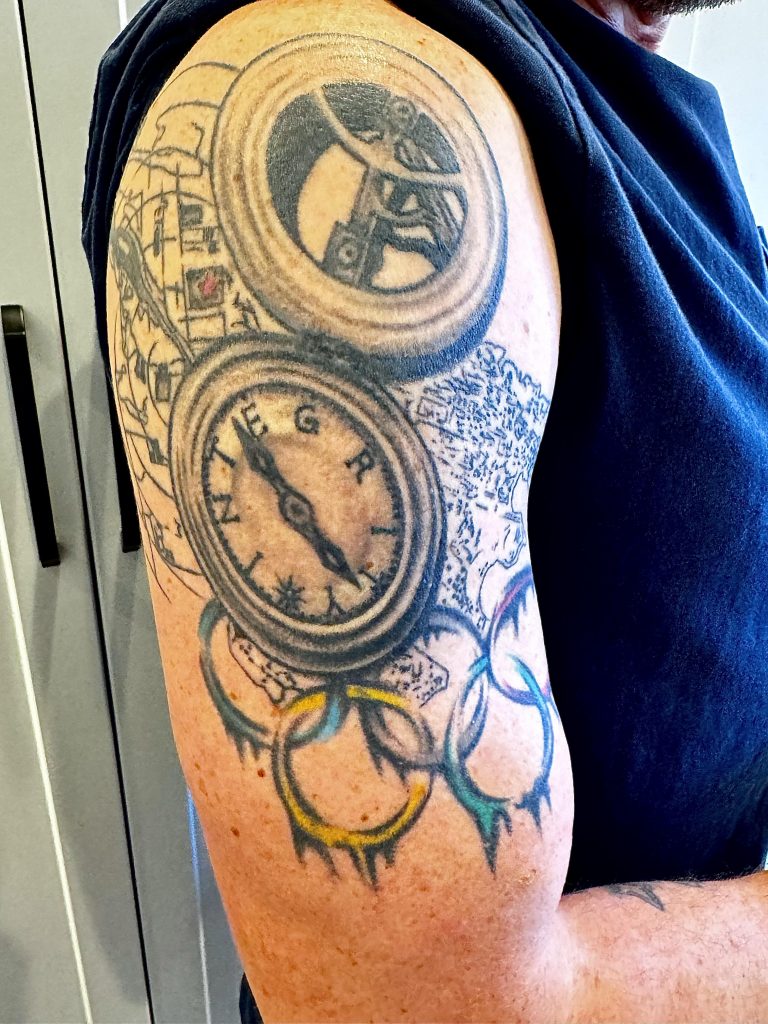You Just Made the Olympics. What’s Next? The Olympic Rings Tattoo
Over the next two weeks, 130 Americans track & field athletes will earn the right to get one of the world's most exclusive tattoos
By Jonathan Gault
June 18, 2024
Featured content goes behind our Supporters Club paywall after 24 hours. So be sure to visit LetsRun.com every day to not miss any content or join the Supporter’s Club today.
About 10 years ago, Donn Cabral was out with some friends in New York City. They were trying to talk their way into a bar. It was not working.
And then someone decided to play the Olympian card.
“We all forgot our wallets or something,” says Robby Andrews, who was also in the group. “And we had told the bouncer, Donn’s an Olympian. You’ve gotta let us in! He’s represented our country!”
The bouncer was not convinced.
Bullshit, he told them.
So Cabral, slightly embarrassed, removed his shirt. And there, on his right shoulder, were five thin, interconnected rings tattooed in black ink.
The bouncer let them in.
Over the next two weeks, around 130 American track & field athletes will qualify to represent their country at the 2024 Summer Olympics in Paris. They will also earn the right to join another exclusive club: that of the Olympic rings tattoo.
The membership in the tattoo club is as diverse the Olympics themselves, from sprinters Justin Gatlin (right collarbone) and Noah Lyles (lower right ribs) to marathoners Kara Goucher (left arm) and Dathan Ritzenhein (left calf), from gold medalists like Allyson Felix (right leg) and Aries Merritt (left arm) to those who exited in the prelims, like Mason Ferlic (right biceps) and Christian Smith (right shoulder).
The Olympic rings tattoo transcends countries — Australian distance runner Genevieve Gregson has them tattooed on her right hip, inside an outline of her homeland. It even transcends sports. Gymnastics and swimming GOATs Simone Biles (right forearm) and Michael Phelps (right hip) both have the rings. So does Rickie Fowler (right forearm), who got inked after golf returned to the Games in 2016 following a 112-year absence.
The tattoo comes in all sizes, from Molly Seidel‘s small, simple rings on her left arm to Evan Jager‘s full-color rings that occupy most of the right side of his upper body.
Really, there’s only one rule.
“You get Olympic rings on you, you better have made the Olympic team,” says 1996 steeplechase Olympian Marc Davis.
It’s not an official rule, of course. A tattoo parlor is not going to turn down business if John Q. Track asks to get the rings. But if you’re brazen enough to get them without making it to Olympus, be prepared for some awkward conversations — especially if an actual Olympian notices them.
Cabral, who competed at the 2012 and 2016 Olympics in the steeplechase, once saw an older woman with the tattoo in a grocery store. When he asked her about it, she told him she had medalled at the Senior Olympics, an event for US citizens age 50 and up that includes events such as cornhole and shuffleboard.
“I’m sure it was well-deserved and very meaningful, but it was a little annoying,” says Cabral.
Then there is a case like Yared Nuguse. The 1500-meter runner made the US Olympic team in 2021 and traveled to Tokyo but injured his quadriceps days before his race. Despite warming up for his preliminary heat, Nuguse did not compete at the Olympics so as not to aggravate his injury.
Growing up, Nuguse had said he would only get a tattoo if he made it to the Olympics. After Tokyo, he felt he had earned the right to get them but chose not to.
“I still felt like I was an Olympian, but I didn’t want to explain the story every time someone asked,” Nuguse says, adding that he would consider getting the rings if he makes the team again in 2024 and would “definitely go for it” if he earns a medal in Paris.
Monzavaous “Rae” Edwards — now known as Raes Take to internet sprint fans — got the rings tattoo in 2016 despite never competing at the Olympics. Edwards had switched allegiance from the USA to Nigeria in 2014 (he gained citizenship through his mother’s ancestry), and admits one of the reasons was so that he could finally compete at an Olympics. Edwards had represented the US at the 2009 Worlds in the 100 meters, but in 2016 he was 35 years old and knew the path to Rio would be much easier representing Nigeria.
In 2016, Edwards only competed once before the Nigerian championships. In that meet, in Austin in June, Edwards ran 10.16 — the Olympic standard on the nose — with a 1.9 m/s tailwind, just 0.1 below the maximum for a legal time.
“To me, it was destined at that point,” Edwards says. “I put all my eggs in one basket, and it worked.”
Edwards only finished 5th at the Nigerian championships, but since only two other men had the Olympic standard, he was on the team. He was so excited that as soon as the Nigerian federation announced the team in July, he rushed to a Dallas tattoo parlor to get the rings on his left biceps.
But Edwards did not compete in Rio. Though the Nigerian federation had publicly named him to the team, it did not submit Edwards’ name in its official entries to the IAAF, which Edwards says was related to his transfer of allegiance (even though he had competed for Nigeria at the African Championships in 2014).
Despite not running at the Games, Edwards says he still considers himself an Olympian “1000%,” saying he “rightfully earned to be there.” Those awkward conversations with strangers about not actually competing? Edwards does not mind them.
“By the time I’m done explaining to them why I didn’t get to run, they typically are like, you deserve that and earned that,” Edwards says.
Edwards says one athlete has pushed back on his tattoo, claiming he needed to “touch the track” at the Olympics to get the rings. But he says every other Olympian he has talked to has been supportive.
“If I can say it the way they were saying, it was like, ‘Bro, that’s fucked up,’” Edwards says. “None of them care.”
***
Mom (Usually) Knows Best
While the Olympic rings, based on a design by Olympics founder Pierre de Coubertin, were introduced in 1913, the tattoo is a more recent trend. Swimmer Chris Jacobs is believed to be the first athlete with the tattoo, getting inked in Hawaii on his way home from the 1988 Games in Seoul. By the 1990s, the tattoo had made the leap across sports, and by the 2000s it had become self-perpetuating in track & field.
“It was always something that when you’re qualifying or aspiring to be an Olympian, you notice it in other Olympians that you look up to,” says two-time Olympian Clayton Murphy.
Grant Holloway was inspired to get the rings after noticing them on Christian Coleman‘s left biceps after the 2016 Games. When Holloway made his first team in 2021, he already had a tattoo sleeve on his left biceps, so he got the rings on his right.
“Christian Coleman is a big brother to me,” Holloway says. “I would say I definitely copied him.”
Holloway, who got his first tattoo at age 19, was already an ink veteran by the time he made the Olympics, but the rings tattoo also holds an appeal for athletes who would never otherwise get one. Like Nuguse, Courtney Frerichs is one of a number of athletes who decided early on they would only get a tattoo if they made it to the Olympic Games.
“If I get a tattoo, I want it to mean something my whole life,” says Frerichs, who made the steeple team in Rio in 2016 and earned a silver medal in Tokyo in 2021. “And having gone to the Olympics will mean something my whole life.”
The rings are even mom-approved. When an 18-year-old Nick Symmonds told his mom he would get a tattoo if he ever made an Olympics, she responded that he not only had her permission; she would pay for the tattoo herself. Evan Jager may have the largest rings tattoo of any runner, roughly 10 inches wide by four inches tall running down the right side of his ribs. He has his mom, Cathy, to thank for the super size — even though she was against the whole idea initially. Jager had printed out a number of possible sizes for the design upon returning home from the 2012 Games in London. Once she realized Jager was committed to the ink, Cathy told her son she thought the largest one looked the best.
“Basically go big or go home,” Jager says. “I was super shocked.”
Cabral’s story is similar to Symmonds. At a young age, he had promised his mom, Deborah, that he would only get a tattoo if he made the Olympic Games. Once he made the team in 2012, Cabral told her he was thinking about getting the tattoo on his right shoulder. Unlike his fellow steepler Jager, however, he had to ignore his mom’s advice.
“She said to me why not centered, maybe in the low back?” Cabral says. “And with no shade to people who get tattoos there, I had to explain to my mom at that point the concept of a tramp stamp.”
***
The Big Question: Where to Put the Rings?
For most Olympians, competing at the Games is the culmination of years upon years of hard work. But that Olympic high is often followed by the Olympic hangover — the search for purpose and direction that sets in after fulfilling a lifelong dream. One short-term remedy? A trip to the tattoo parlor.
Andrew Wheating got his Olympics rings at the High Priestess in Eugene in the fall of 2008. The tattoo parlor was just a few blocks away from where he had made the team that June at Hayward Field in one of the most famous races in Olympic Trials history — the Oregon sweep with fellow Eugene-based 800 runners Nick Symmonds and Christian Smith. They felt it was only appropriate to get tattooed as a group.
“It was all of our first Olympics, we went through team processing together, we went through getting our gear together, flying to Beijing together, checking into the village together, all these phases,” Wheating says. “At one point, we just sat down and looked at each other and realized what we had done was incredibly special and we have to get tattoos together. This is something that is a life-changing moment that we need to document and make it official.”
Wheating got the rings in the same spot as Symmonds and Smith — right shoulder — but with a twist. One of the decisions any Olympian faces is whether to get the rings in color or all black. Wheating split the difference, getting the top three rings in black but the bottom two in yellow and green — a nod to the University of Oregon, in whose singlet he had made the team. Wheating likened the feeling of getting that tattoo to that of a bee sting, but says it also felt soothing knowing that the rings on his shoulder would cement a lifelong bond with his Olympic teammates.
“Anytime we’re in the same room, it’s always that wink to one another,” Wheating says. “You remember that time? Yeah. It’s on my shoulder.”
Clayton Murphy got his rings in the same spot on his body in the fall of 2016 and says the experience was not that painful — though not because it was soothing.
“I was so hung over and had the worst headache in the world,” Murphy says. “A little pinching of the tattoo on the shoulder was not much compared to the headache I was having.”
Murphy had gone to get inked in Akron with his roommate at the Rio Olympics, Robby Andrews. But when they got to the tattoo parlor, Andrews had no desire to get the rings. Murphy, then 21, was on top of the world — a bronze medalist in the 800 who had just signed a lucrative sponsorship contract with Nike. Andrews, meanwhile, had been disqualified in the semifinals of the 1500, and the experience was still fresh. Despite making the team and competing in Rio, Andrews felt he had not “earned” the rings.
“I wanted nothing to do with remembering my Olympic experience,” Andrews says. “It was this big open wound on my soul and my person. The thought of putting the most embarrassing moment of my life on my body forever, no way.”
That sentiment is not uncommon among athletes who feel they underperformed at the Games. Marc Davis took the unorthodox step of getting his rings tattoo after making the team but before the Olympics in the summer of 1996. In retrospect, Davis says he is glad he got the tattoo straight away, given he broke his foot at the Olympics and finished last in the final.
“I don’t know if I would have gotten the Olympic rings if I would have waited until after the Olympics after having such a bad experience,” Davis says.
Davis also says he has no regrets about where he got his tattoo: across his midriff with the top middle Olympic ring encircling his bellybutton.
“At the time, I had my bellybutton pierced,” Davis says. “So I was already trying to draw some attention to the area on my body…I don’t quite have the gut and the belly I had when back I was an Olympian. Things are a little stretched out now.”
Davis has 16 tattoos — including a swoosh, for which he was paid a bonus by Nike — but it is the rings that draw the most attention.
“If I’m on vacation somewhere and I’m walking around in a bathing suit, I’ll get the double take,” Davis says. “…I’ll walk on by and I’m like, That’s right, you saw that. You saw that. Because you’re proud of that.”
Where to get the rings is a big question. Some athletes opt for a spot that is clearly visible — Holloway loves the having the rings on his biceps.
“I’m an Olympian,” Holloway says. “I want everybody to know. I worked hard for it.”
Others, like Jager, prefer a spot that can be concealed by a t-shirt if they are in a situation where they’d rather not have a tattoo showing. Kara Goucher chose a spot on her lower left arm, near a tattoo of her home state of Minnesota. It was an intentional choice to put Minnesota above the rings.
“Being from Minnesota is so much more important to me than being an Olympian,” Goucher says.
Some choose the location specifically with the act of running in mind.
“I remember back then thinking oh, when you’re running, I want the person behind me to see it,” says Ritzenhein, who got tattooed on his calf. “…Often when you’re running, you’re either looking at the person’s shoulder or when you’re starting to hurt a little bit you start to look down. And so they would look down to the calf.”
Murphy chose the back of his right shoulder — a popular location — because he realized that it would always be facing the outside of the track while he was racing.
“I remember trying on my jersey and being like, well this is where I want it because this is outside of the realm of a singlet,” Murphy says. “Obviously as gear has come along and jerseys evolve, that’s not always the case.”
Wheating chose the same location, and it made an impression on a young Robby Andrews — not yet an Olympian himself — when they raced during Andrews’ freshman season at the University of Virginia.
“He’s literally a foot taller than me,” Andrews says. “My eyeline is at his shoulder blades. So I’m just starting at his Olympic ring tattoos and I just remember thinking how cool they were.”
***
The Personal Touch
The Olympic rings are a universal symbol. Well, almost universal — Emma Coburn, who has the rings tattoo on her left foot, has been asked more than once during pedicures if she is just a really big Audi fan. But tattoos are deeply personal. As a result, many Olympians opt to personalize their rings tattoo.
Holloway’s rings are enclosed in a laurel wreath, with “2020ne” written in small type to the left — a nod to the 2020 Games being delayed to 2021. Frerichs did not plan on getting a second tattoo after she got the rings on the right side of her ribcage in 2017. But after she medalled at her second Olympics in Tokyo, she got a cherry blossom branch (a national symbol of Japan) and the word “belong” (her mantra for the race) tattooed on the same spot on her left ribcage.
Frerichs’ former Bowerman Track Club teammates Karissa Schweizer and Elise Cranny both made their first Olympic team in 2021 in the same event (5,000m) so, like the 2008 men’s 800 squad, they felt it was only fitting to get inked together as well. While they chose different places (left ribs for Cranny, right ankle for Schweizer), both got the same design, created by Schweizer herself, which featured the letters XXXII embedded in the bottom left ring — a nod to Tokyo’s status as the Games of the XXXII Olympiad.
Aries Merritt put his rings on top of a winged spike and above a logo of London 2012, the Games where he won gold in the 110-meter hurdles. Manteo Mitchell had a slightly different experience at those Olympics. Halfway through the first leg of the 4 x 400 relay prelims, Mitchell broke his left fibula, but he kept running a split 46.1, allowing the USA to make the final and ultimately earn a silver medal.
Prior to the Games, Mitchell had considered incorporating the rings in the sleeve tattoo he had begun on his right arm. But he quickly realized this was the race that would define his career and felt it was only appropriate to get the rings on the spot on his left leg where the fracture had occurred. Mitchell built out a design around the rings, including a laurel wreath, a stopwatch, and a cross (“because I kept the faith and finished the race,” he says), all enclosed within a snowglobe, which Mitchell felt added a magical element to represent his Olympic dream becoming reality.
Mitchell’s injury did not require surgery, and his broken bone was still healing when he got the tattoo a couple of weeks after returning from London. Because of the size and complexity of the design, the tattoo required around six hours to complete, further complicated by the fact that Mitchell was not exactly mobile at that point. Fortunately, he found an artist from Charleston, S.C., who was willing to drive five hours to Mitchell’s house in Cullowhee, N.C., to complete the job. For Mitchell, the act of getting inked was a cathartic experience, a coda to his experience in London.
“It was very therapeutic for me,” Mitchell says. “…I just went through that pain, re-lived that pain [of the race].”
Recently Mitchell, 36, has been thinking about an addition to his Olympic tattoo: two years ago, he switched to bobsled and is currently trying to qualify for the 2026 Winter Olympics.
“A lot of the bobsledders and skeleton athletes, they have the tattoo as well,” Mitchell says. “…Just talking about the struggles and the likes, the dislikes, from one sport to another, it’s pretty cool to see the differences but also knowing that we’re all after the same thing, which is one of those three medals.”
***
A Different Kind of Tattoo
When Adam Goucher returned from the 2000 Olympics in Sydney after competing in the 5,000 meters, he saw many of his fellow Olympians get the rings tattoo. He wanted to get it too, but not right away. His plan was to wait until his career was over, then get the rings along with the years of each team he made: ’00 – ’04 – ’08…
“I just assumed I will definitely be on a few more of these teams,” Goucher says. “And it never played out for me.”
Like many young runners, Goucher had grown up watching the Games on television and thinking how cool it would be to be a part of the spectacle one day. To him, the Olympic rings had represented something pure.
“That was kind of always that ultimate goal in life when it came to my running, was to be an Olympian,” Goucher says.
But by the time he retired in 2011, Goucher had begun to feel differently. While he had had an “amazing” experience in Sydney, his running career had not lived up to his own high expectations. He did not think he would ever feel worthy of getting the rings on his body, where they would only serve as a reminder of his disappointing finish in Sydney and failure to return to the Olympics.
Yet in 2016, a 41-year-old Goucher was at a studio in Boulder, finally getting his rings, 16 years after he had earned them. But they were just one part of a much larger tattoo across his upper right arm. Goucher had decided he wanted a tattoo that was representative of who he was — a mural to the life he had lived. The design included a map of Portland, with a star representing the hospital where his son Colt was born. There was a literal moral compass with the word “integrity,” because Goucher always felt he had tried to do the right thing, inside and outside of running.
And at the bottom were five interlocked rings, the ink running off them as if they were melting. Goucher had dedicated his athletic career to chasing those rings, and a few years post-retirement, he concluded that, for better or worse, the Olympics had comprised a significant chapter in his life.
But Goucher did not feel it was appropriate to get the pristine, shiny version of the rings he had seen on television. The version of the Olympics — and professional running more broadly — that Goucher had experienced was dirtier and more complicated than his adolescent dreams. Goucher had concluded that the Olympics were a business, and not a fair one: while a few individuals at the top were getting rich, the vast majority of athletes were not.
Also fresh in his mind was what had happened to his wife, Kara Goucher, who had finished 4th at that year’s US Olympic Marathon Trials behind Amy Cragg and Shalane Flanagan, who were wearing early versions of the Nike Vaporfly shoes that would revolutionize the sport.
“Kara missed her third Olympic team by one spot because two people in front of her were wearing prototype shoes – aka cheating,” Adam Goucher says.
Goucher’s perspective on the Olympics has changed throughout his life, but he is at peace with having his version of the rings on his body. Now, when he looks at them, he sees the whole picture: the pride he took in making the team, as well as the disillusionment that followed. Goucher wanted a tattoo that represented his life. And every life contains good and bad, ups and downs.
“I would imagine that 90% of people would not agree with my take on it and that doesn’t matter to me,” Goucher says. “This is mine, this is my experience.”
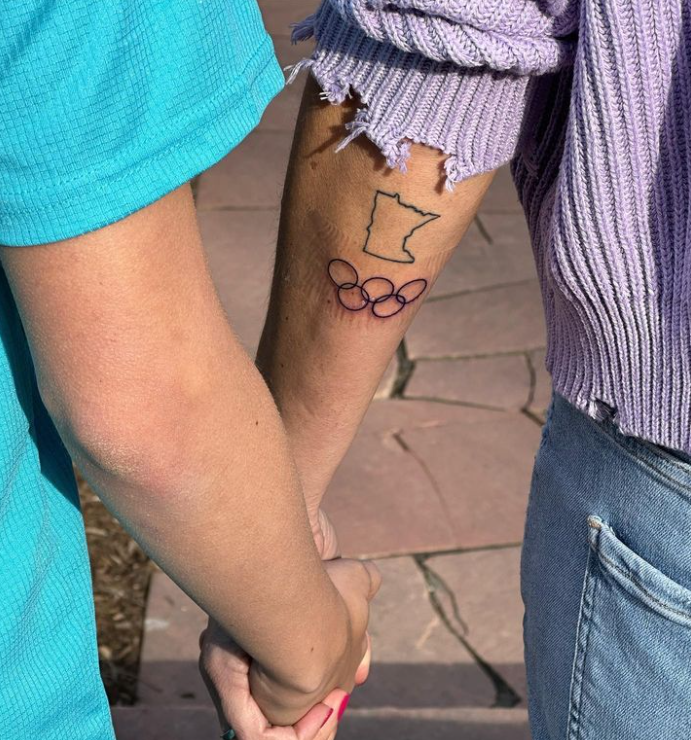 Kara Goucher would not have gotten the rings without her son Colt. (Courtesy Kara Goucher Instagram)
Kara Goucher would not have gotten the rings without her son Colt. (Courtesy Kara Goucher Instagram)
Kara also waited a while to get her rings. She did not get the tattoo until 2023, nearly 15 years after making her first team. Like Adam, Kara felt she had underperformed at her Olympic appearances in 2008 and 2012 and did not feel as if she had earned the rings. Ahead of the 2016 Olympic Marathon Trials, she told herself she would definitely get the tattoo if she made a third team at age 37, but she finished 4th.
“I just decided I would never get it,” Kara says.
But a couple of years ago, Kara’s son Colt Goucher, now 13, joined a youth running team in Boulder. One of his teammates was Jude Ritzenhein — son of Dathan. Whenever Dathan came to pick up Jude from practice, Colt could not help but notice the rings on Dathan’s calf.
“He kept pestering me like, Mom, why don’t you have one?” Kara says. “You went to the Olympics, it’s a big deal. And he just kept talking about it nonstop.”
After a year of pestering, Colt wore her down. Last year, Kara finally got the rings.
“I was just like, I am an Olympian and it was a huge childhood goal for me, just seeing it through Colt’s eyes,” Kara says. “Honestly, I got it for him.”
***
More Tattoos to Come in 2024?
When Kara Goucher got her tattoo, Robby Andrews took notice.
“For her to be able to go and get the rings later on after everything she’s been through, it kind of woke me up a little bit like, you know, I am still an Olympian and I always will be and I will always have that option if I ever get the urge,” Andrews says.
Right now, Andrews does not have the urge. He’s just not a tattoo guy. But loved ones have a way of changing our perspective. This week, his wife, Josette Andrews, will compete at the US Olympic Trials, where she is among the top contenders in the 5,000 meters. Josette already has two tattoos, and Robby knows she would want the rings if she made the team. He suspects he would have the urge to get them as well.
“If she went, I would 100% go with her,” Robby says. “That would be a really cool moment in our relationship…It’s the people you meet along the way that really make things worthwhile.”
Just as there is no such thing as a “former” Olympian, there is no expiration date on Olympic rings tattoos. Des Linden has made two teams and has yet to get the tattoo. Linden says it has been too long to get it now, but Kara Goucher, her 2012 Olympic teammate turned podcast co-host, says Linden has definitely thought about it.
“She says knows the spot where she would put it and she doesn’t say because she doesn’t want anyone to copy it,” Kara says. “…I feel like after some marathon where we’ve been drinking, I could probably talk her into it.”
Carrie Tollefson, who made the 2004 team in the 1500 meters, also never got the tattoo. But Tollefson says that, for a number of reasons, the time feels right to get the tattoo in 2024. It will be the 20th anniversary of her team, she will be in Paris doing commentary for the Olympic Broadcasting Service, and it would be a fun thing to do before she turns 50 in a few years.
But what put it over the top was seeing Dakotah Lindwurm — like Tollefson, a proud Minnesotan — make the Olympic marathon team in February. Tollefson lives in the Highland Park area of St. Paul, where Lindwurm occasionally runs workouts as part of Minnesota Distance Elite. One day after the Olympic Marathon Trials in Orlando, Tollefson was driving around her neighborhood when she noticed a tattoo shop and fired off a text to Lindwurm:
Just passed a new tattoo place in Highland. I haven’t gotten the rings yet but after Paris, want to go get one together?? 😜
Lindwurm’s response?
Omg!!! YES!!!!! Absolutely!!!
Talk about this article on our world-famous messageboard / fan forum: Jonathan Gault’s latest feature: “You Just Made the Olympics. What’s Next? The Olympic Rings Tattoo”.
